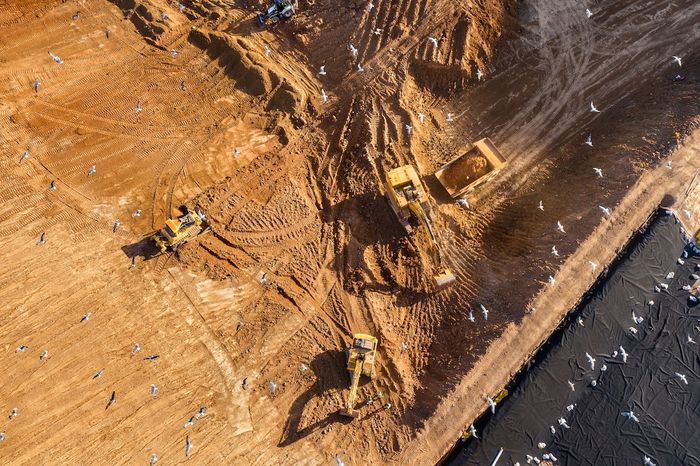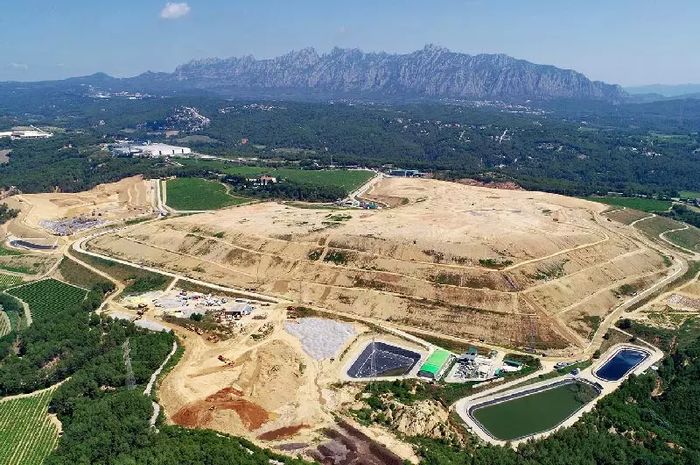Nationalgeographic.co.id—Fossil–fossil ancient animal often found in unexpected places. One of them, garbage dump or final dump (TPA).
A garbage dump in Spain became a “treasure” mine paleontology which saves a lot fossil ancient animal. Some of them are a number primate which are considered the predecessors of apes and humans as well as 85 species of mammals that coexisted with para primate prehistoric that.
Over the past few months, several paleontolog spend a few nights a week at Abocador de Can Mata, garbage dump largest active in the region of Catalunya, Spain, it’s to dig more fossil ancient. Seven days a week, 24 hours a day, a number of excavators have stuck their metal claws into the ground in a hurry to make another deep hole to accommodate the rubbish from Barcelona and its surroundings.
Joseph Robles is one of the eight experts paleontology who took turns watching the brownish-yellow earth stones that the diggers had moved. During the day, the sickly stench attracts flocks of seagulls. Dirt, as small and fine as powdered sugar, rose to the sky with every step Robles took.
At night he wears layers of clothing, headlights strapped to his project helmet. Every time he saw an object that seemed to be a fossil, he waved at the excavator operator to stop digging the ground, while he probed the object more closely.
If fossil it still looked promising, he covered it with flashy silver foil and opened it again in the morning to research it further. Then he backed away, gave clear instructions, and the roar of the engine would start once more.
Also Read: New Dinosaur Species Discovered, Becomes Australia’s Biggest Find
PAOLO VERZONE
–
One of the paleontologists working in Can Mata.
–
The land of Can Mata holds a wide range of fossils spanning over a million years in the Miocene period, from about 11.2 million to 12.5 million years ago. Since 2002, Robles and other paleontologists from the Catalan Institute of Paleontology Miquel Crusafont (ICP) at the Autonomous University of Barcelona, have found more than 70,000 fossils from this period. The animal fossils include horses, rhinos, deer, elephant relatives called probocideas, early relatives of the giant panda, and the world’s oldest flying squirrel. There are also many ancient remains of rodents, birds, amphibians, and reptiles.
But among the most important discoveries were the fossils of a primate species found nowhere else but the landfill. This primate species may have been an ancestor of hominids or a precursor to modern primates such as gibbons, great apes, orangutans, gorillas, chimpanzees, and possibly humans.
There were dozens of hominid species that lived during the Middle Miocene period. They originated in Africa, but as of 12.5 million years ago, they also appeared in Asia and Europe. The primate bones found at Can Mata help fill in the picture of a period far in our past that, in many ways, remains murky.
“Can Mata has allowed us to show that primates were much more diverse in that time span than previously thought,” said David Alba, director of ICP, as reported by National Geographic.
And each new fossil clue helps us unravel some of the deepest mysteries of our species: Who are we? Where do we come from? And when did we start being who we are?
Located about 30 miles northwest of Barcelona, the name and area of Can Mata landed on primate fossil maps in the early 1940s when paleontologist Miquel Crusafont discovered a portion of the mandible and teeth of a Miocene great ape at the site. Subsequent findings helped establish Can Mata as a documented paleontological site. Although known as a site that holds a lot of potential valuable fossils, Can Mata has been operating legally as a garbage dump since the mid-1980s.
Also Read: Getting to Know Ardi, the Species Suspected as Ancestor of Humans

PAOLO VERZONE
–
One of the fossils found in Can Mata.
–
In the early 2000s, when site operator Cespa Waste Management wanted to excavate a new waste collection cell at least 100 feet deep, the company was obliged under Spain’s Historical Heritage Law to ensure its machinery did not destroy fossils or bury them under mounds of garbage. Cespa approached some of the scientists who discovered the fossils to supervise the excavations, and they took the opportunity to access the depths of the dump.
In 2002, freelance paleontologists Isaac Casanovas-Vilar, Jordi Galindo, and Alba, who was then a Ph.D. began monitoring excavations at Can Mata. Three weeks into the work, they discovered the teeth of a dinothere, a very large relative of the elephant with tusks curved downwards. Investigating the place more closely, they found a fragment of a finger bone. “To my surprise, it looked like a primate,” recalls Alba.
Alba ran to her car and took a hand cast of the extinct Hispanopithecus ape, which was found in a nearby valley. The paleontologists compared the two but still weren’t sure what they found. Next they found three canine fragments, which Alba had glued together, and a pile of small, fragile bone fragments scattered near the sedimentary block. Camera in hand, Alba lay on his stomach to get a better look at the bottom of the block.
Also Read: ‘Broken Hill’ Skull Evaluates Modern Human Evolution

PAOLO VERZONE
–
Paleontologists working at Can Mata.
–
He was shocked to realize that he was face to face with an ancient face. “The three of us, so nervous—we barely spoke—picked it up,” he said. “And there was Pierolapithecus’s face staring at us. So it was one of the biggest moments of my life.”
Pierolapithecus catalaunicus, nicknamed Pau, is a new species of great ape they discovered. About 12 million years old, this is one of the most complete Miocene primate skeletons ever found. The team continued to dig and eventually recovered additional bones from the animal’s chest, lower back and wrists. It is the oldest known primate fossil showing clear evidence of a unique characteristic of apes and humans: creatures that walked upright.
The team at Can Mata were also thrilled to discover another new hominid called Anoiapithecus brevirostris, which dates back about 12 million years. Most of the primate’s faces are prominent, but the face of this petrified male, nicknamed Lluc, is so flat that it reminds us of faces in our own genus, Homo. The researchers propose that this is the result of convergent evolution, where similar characteristics evolve in unrelated or distantly related organisms.
Also Read: For the first time, scientists find fossilized eggs containing baby dinosaurs

PAOLO VERZONE
–
Excavation site in Mata can.
–
Then in 2011 a fossil emerged of a female Pliobates cataloniae dubbed Laia. This newly discovered species lived about 11.6 million years ago, about half a million years younger than Pau. He was small, weighing about the same as a domestic cat, but paleontologists were surprised to find that he had some ape features, such as his wrist bones and the gibbon-like shape of his skull.
Understanding the roots of great apes is important for understanding the origins of hominins, the taxa that emerged after our lineage and that of chimpanzees split from their common ancestor six million to eight million years ago. Human bloodlines “don’t just appear,” Alba said. “So we need to know where they evolved from.”
Also Read: Megalodon Fossil and Other Ancient Marine Animals Found in Sukabumi
PROMOTED CONTENT
Featured Videos
– .


